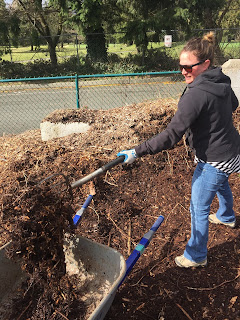Service Learning- Volunteering on the EDCC Community Campus Farm and learning about ways to better the environment we live in. 2 Hours
Megan Thees
For my service learning project, I volunteered on the EDCC campus farm for two days. The first day, March 6th, For one hour I pitch forked bark into wheel barrows and transported it around the farm to places it was needed. Local arborist’s donate their wood chips from cut down trees to EDCC because they can use them around the farm, whereas otherwise the arborist’s would have to pay a disposal fee elsewhere. It is used around the farm on the walk ways around the garden beds. It is useful because it helps keep down the weeds in the spring.
 The goal of this project was to prepare the farm for spring. If we lay the bark before the weather gets too warm, the amount of weeds will be reduced meaning less work spent on getting rid of weeds and more time for more important tasks on the farm. This was not easy work, making me realize it takes a lot of effort to run a farm and that it why it is important that they get volunteers to distribute the work. I enjoyed working on the farm even though it was hard work, but I realize the importance of volunteering and giving back to the community and I would like to continue doing so.
The goal of this project was to prepare the farm for spring. If we lay the bark before the weather gets too warm, the amount of weeds will be reduced meaning less work spent on getting rid of weeds and more time for more important tasks on the farm. This was not easy work, making me realize it takes a lot of effort to run a farm and that it why it is important that they get volunteers to distribute the work. I enjoyed working on the farm even though it was hard work, but I realize the importance of volunteering and giving back to the community and I would like to continue doing so.  |
| Freshly laid bark |
Next Marni took us back outside to look at the Rain garden. I thought this was very interesting because I had never heard of this but apparently they are quit common in the Seattle area, since we get so much rain. Basically it is a water retention area, shaped like a pond, with lots of plants that can withstand heavy rain. The ground is made up of different levels of substrate to help slow down the flow of water into the ground. The EDCC Rain Garden is an all edible Rain Garden. Rain gardens help their immediate surroundings by reducing water pollution, prevent flooding, low maintenance landscapes, and they help the community save millions of dollars in pollution clean-up and expensive stormwater projects. Rain gardens are necessary now because of the lack of native forest, due to the massive amounts of building happening in our city. Rain gardens act like native forest and infiltrating polluted run off from rooftops, driveways and other hard surfaces.
Without rain gardens, the oil and other pollutants from the roofs and driveways of houses and streets and sidewalks go straight into the waterways of the puget sound. With rain gardens fish and wildlife benefits by keeping pollution out of our rivers and streams and ultimately puget sound. Rain gardens also provide habitat for bees, birds, butterflies and other wildlife, they help improve air quality and reduce the carbon footprint. I would like to make a rain garden to help the Puget Sound area reach their goal of 12000 rain gardens. We talked a lot about fish in this class and how we can be effected by eating fish. If the fish are polluted by the water that they live in then we in turn can be polluted from eating the fish.
I liked this sticker that was on the door of the farm shed. If there are things we can do to help our environment then we should do those things. If we want a brighter and healthier future, let’s make it happen. I like the sustainability of the campus farm and I hope to continue to volunteer and do these strategies in my own life to help our community. The campus farm is benefiting our environment, the wildlife in our area and reducing our carbon foot print and they provide fresh produce and plants to our community at lower costs. We as people do a lot to harm our environment without even thinking about it, so it made me feel really good to do something to better the environment in my community.
Questions that came up during my service learning:
- How often do you re-bark the walkways?
- -every spring to reduce the weeds
- What type of plants are good for rain gardens?
- Blueberries, native plants, hardy cultivars
- What filters the water in the rain garden?
- roots of plants and different levels of substrate material in ground, (gravel, dirt, etc) “bioretention mix”
- What is the white cloth in the hoop house covering the plants and what is it used for?
- Keeps plants warm at night, protects from too much sun, and keeps pests down




No comments:
Post a Comment